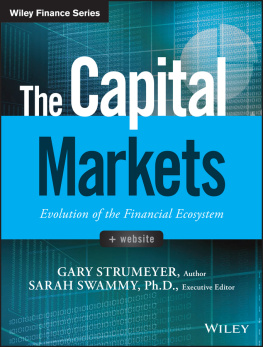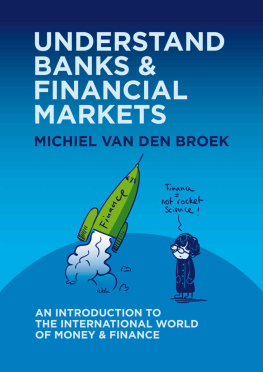
Table of Contents
List of Tables
- Chapter 4: Cash Bonds and Futures
- Chapter 5: Risk in Capital Markets
- Chapter 7: Making Markets Work
- Chapter 9: Repurchase Agreements
- Chapter 11: GovernmentSponsored Enterprises and Federal Agencies
- Chapter 12: InflationLinked Bonds
- Chapter 13: MortgageBacked Securities
- Chapter 14: Corporate Bonds
- Chapter 15: Preferred Stock
- Chapter 17: Securitization
- Chapter 18: AssetBacked Securities
- Chapter 19: NonAgency Residential MortgageBacked Securities (RMBSs)
- Chapter 20: Commercial MortgageBacked Securities (CMBSs)
- Chapter 21: Collateralized Debt Obligations (CDOs)
- Chapter 23: Collateralized Loan Obligations (CLOs)
- Chapter 25: Equities
- Chapter 26: Cash Equities in the Secondary Market
- Chapter 28: Equity Capital Markets
- Chapter 29: Interest Rate Swaps
- Chapter 30: Interest Rate Options
- Chapter 31: Commodities
List of Illustrations
- Chapter 1: The Early 21stCentury Evolution of Global Capital Markets
- Chapter 2: The Role of Global Capital Markets
- Chapter 3: How the Global Financial Crisis Transformed the Industry
- Chapter 4: Cash Bonds and Futures
- Chapter 5: Risk in Capital Markets
- Chapter 6: Enablers for Robust Risk Management in Capital Markets
- Chapter 7: Making Markets Work
- Chapter 8: Money Markets
- Chapter 9: Repurchase Agreements
- Chapter 11: GovernmentSponsored Enterprises and Federal Agencies
- Chapter 12: InflationLinked Bonds
- Chapter 13: MortgageBacked Securities
- Chapter 14: Corporate Bonds
- Chapter 17: Securitization
- Chapter 18: AssetBacked Securities
- Chapter 19: NonAgency Residential MortgageBacked Securities (RMBSs)
- Chapter 20: Commercial MortgageBacked Securities (CMBSs)
- Chapter 22: Structured Investment Vehicles (SIVs)
- Chapter 23: Collateralized Loan Obligations (CLOs)
- Chapter 25: Equities
- Chapter 26: Cash Equities in the Secondary Market
- Chapter 28: Equity Capital Markets
- Chapter 29: Interest Rate Swaps
- Chapter 30: Interest Rate Options
- Chapter 33: Conclusion
Guide
Pages
Copyright 2017 by Gary Strumeyer. All rights reserved.
Published by John Wiley & Sons, Inc., Hoboken, New Jersey.
Published simultaneously in Canada.
No part of this publication may be reproduced, stored in a retrieval system, or transmitted in any form or by any means, electronic, mechanical, photocopying, recording, scanning, or otherwise, except as permitted under Section 107 or 108 of the 1976 United States Copyright Act, without either the prior written permission of the Publisher, or authorization through payment of the appropriate per-copy fee to the Copyright Clearance Center, Inc., 222 Rosewood Drive, Danvers, MA 01923, (978) 750-8400, fax (978) 646-8600, or on the Web at www.copyright.com. Requests to the Publisher for permission should be addressed to the Permissions Department, John Wiley & Sons, Inc., 111 River Street, Hoboken, NJ 07030, (201) 748-6011, fax (201) 748-6008, or online at http://www.wiley.com/go/permissions.
Limit of Liability/Disclaimer of Warranty: While the publisher and author have used their best efforts in preparing this book, they make no representations or warranties with respect to the accuracy or completeness of the contents of this book and specifically disclaim any implied warranties of merchantability or fitness for a particular purpose. No warranty may be created or extended by sales representatives or written sales materials. The advice and strategies contained herein may not be suitable for your situation. You should consult with a professional where appropriate. Neither the publisher nor author shall be liable for any loss of profit or any other commercial damages, including but not limited to special, incidental, consequential, or other damages.
For general information on our other products and services or for technical support, please contact our Customer Care Department within the United States at (800) 762-2974, outside the United States at (317) 572-3993 or fax (317) 572-4002.
Wiley publishes in a variety of print and electronic formats and by print-on-demand. Some material included with standard print versions of this book may not be included in e-books or in print-on-demand. If this book refers to media such as a CD or DVD that is not included in the version you purchased, you may download this material at http://booksupport.wiley.com. For more information about Wiley products, visit www.wiley.com.
Library of Congress Cataloging-in-Publication Data is available:
ISBN 978-1-119-22054-1 (Hardcover)
ISBN 978-1-119-22057-2 (ePDF)
ISBN 978-1-119-22056-5 (ePub)
Cover Design: Wiley
Cover Image: bluebay/Shutterstock
All royalties from this book will be donated to the Robin Hood Foundation.
Preface
Throughout my career in financial services as an author, educator, and sales executive, and president of a broker dealer, I continue to be amazed by the lack of understanding that the average person has about the evolution of our global capital markets ecosystem. This condition, if left unchecked, can easily become untenable and dangerous in our highly regulated, hyperconnected, techsaturated world. This bookthe first of its kind postFinancial Crisiswill serve as an antidote to this condition. I have assembled the right teampractitioners, academics, and economiststo present clearly in these pages the fundamentals necessary for both professionals and nonprofessionals to learn about what makes up our capital markets ecosystem.
Gary Strumeyer
Acknowledgments
First and foremost I wish to single out the driving force behind our literary adventure by expressing my deepest appreciation and unqualified gratitude to our consummate editor in chief, Dr. Sarah Swammy. Through her ability to find, recruit, and sign the best, most qualified authors, combined with her benevolent taskmaster persona and her laserlike focus on submitting the final drafts well in advance of the original deadlines, she brought to life the vision of this book and ensured the high quality of its contents. She shares with me my belief in the power of thought leadership and motivated the host of talented writers and thinkers to bring this project home with efficiency, speed, and grace. Thank you, Sarah, for your many contributions to this workchief among them keeping me ahead of schedule.
Specials thanks are due to Alberto Baptiste and Peter Borish. Al got the ball rolling by providing us with key resources early in our progress. He was integral in kicking off this endeavor, enabling us to attract industry leaders as contributors. I am also grateful to Peter for his guidance, insight, and connecting us with the Robin Hood Foundation.
I would also like to express my gratitude to all of my friends and colleagues who shared their experience, market insight, time, and contacts to make this book comprehensive and successful: Joe Gaziano, Larry Harris, Ron Hooey, Joe Keenan, Dena Mandara, Lenny Scotto, and Sam Schwartzman.
Thanks, again, to all of the contributors not only for their brilliant submissions but for helping us to identify the trends and subject matter relevant to the evolving financial ecosystem.
Gary Strumeyer
About the Author & Executive Editor
GARY STRUMEYER
 Next page
Next page










